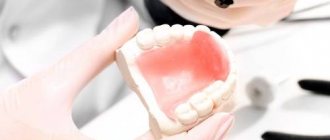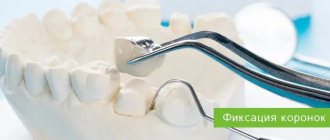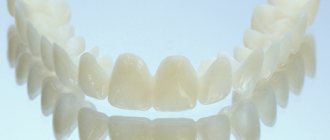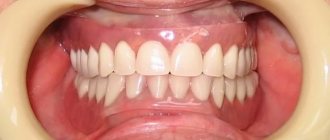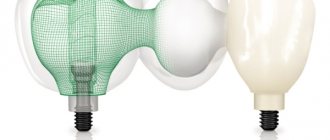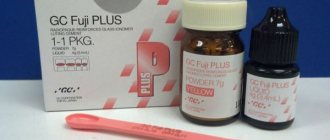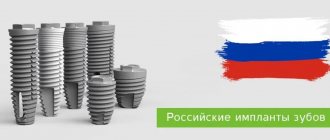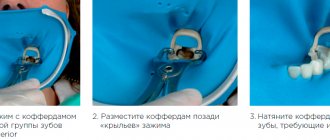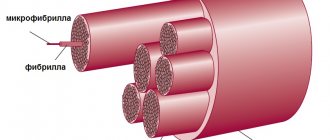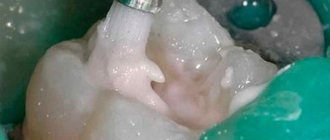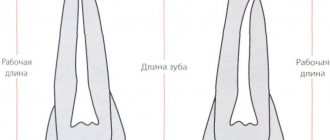The quality of modern adhesive restorations depends not only on their aesthetics, but also on the strength of the bonding component and their own adhesion to the remaining healthy tooth tissues. Such designs even make it possible to restore the previous hardness of the tooth, in particular, if you do not replace healthy tissue with material, but put it on top. Fixation is the most important stage of treatment, and therefore it should be given special attention. This article discusses the fixation of ceramic veneers using modern materials, taking into account their main advantages.
Clinical work was done by Mr. Daniele Rondoni, Styleitaliano, Savona (Italy).
initial situation
Rice. 1 Initial situation: several unaesthetic restorations that do not match the color of the tooth tissue
Rice. 2 You can see cervical caries on the lateral incisor and disproportion of all anterior teeth
Fig. 3 On the right, many defects are also noticeable, such as the opacity of tooth 11, previously treated endodontically and restored with a fiberglass pin, pigmentation of the proximal surfaces, and disproportionality of the teeth.
Rice. 4 The occlusal view is one of the most important aspects in planning veneer treatment. With its help, you can estimate how much restoration material will be needed and how much tooth tissue will have to be removed. In particular, in this patient, the central incisors need to be prepared sparingly (especially in the incisal area), whereas the lateral incisors do not require any preparation at all.
Rice. 5
Making a mock-up
Making a mock-up after wax-up allows you to see the long-term result of treatment. Usually, after approval of the proposed result, you can begin to dissect on top of the Mock-up. In turn, Wax-up is used at further stages of treatment:
1 – preliminary assessment stage;
2 – stage of assessing the depth of preparation;
3 – stage of manufacturing provisional structures;
4 – stage of final assessment of the restoration.
Preparing teeth for veneers
Pay attention to how little tissue was subjected to tooth preparation for veneers (visible from the silicone key). After preparation from the vestibular side, the remnants of the mock-up can be removed and the proximal and cervical surfaces can be processed.
Rice. 6
Rubber dam insulation
The veneers will be fixed one at a time in complete isolation of the working field. Details of rubber dam isolation of tooth 11: clasp 212 is used, adjacent teeth are also isolated for better access to proximal surfaces. The scope of the preparation performed is visible: the enamel of tooth 12 is intact, the central incisors are processed in the area of the cutting edge, the correction of cervical and proximal surfaces is carried out exclusively within the enamel. For better adhesion, the filling material on the surface of tooth 11 was sandblasted using 50 micron aluminum oxide particles.
Rice. 7
Content
- Types of metal-free crowns
- How are crowns made?
- Features of installing ceramics
- How to choose the color of ceramics
- Crowns for front teeth
Crowns are an integral part of restoring lost or damaged teeth. Initially, these elements were exclusively metal, made of steel and gold alloys. Such dentures were not suitable for the front teeth, and plastic substitutes began to be used in this area, despite their fragility, because it was about aesthetics.
Metal-ceramic crowns were a real breakthrough, as they had the excellent aesthetic qualities and durability of metal crowns. However, this option is not without its drawbacks. Patients may experience allergies, and when illuminated at a certain angle, the metal core can be seen through the ceramic.
A new breakthrough was metal-free ceramics. New versions of such prostheses are appearing, differing in cost and properties.
Total etching
Total etching for 30 seconds using phosphoric acid.
Rice. 8
Rice. 9 In any technique for etching tooth tissue, the most important point is the complete removal of acid from its surface. To clean the tooth from all decay products of the etching agent, we recommend rinsing it off for 20 seconds. It is worth remembering that overdrying the dentin surface can lead to the collapse of collagen fibers, so it must be dried carefully. And if you need absolute dryness, you can always choose the self-etching technique.
Rice. 10 Clean matte tooth surface after the etching stage.
Rice. 11 At the same time, the feldspathic veneers were treated with hydrofluoric acid. Depending on the concentration, the acid exposure time changes: 1.5 minutes for 10% and 3 minutes for 5%. A sign of high-quality processing is the surface of the veneer - uniform, matte and clean. Otherwise, this stage should be repeated or (if the desired effect is persistently absent) sandblasting should be used.
Application of adhesive
Apply adhesive within 20 seconds using ScotchBond Universal, which can be used as either a self-etch agent or a total etch technique.
Rice. 12
Rice. 13 The next step is to distribute the adhesive with an air stream over the surface of the tooth so that its excess does not affect the fixation of the veneer.
Adhesive polymerization
Adhesive polymerization stage. Manufacturers recommend carrying out this process for 20-30 seconds, but it is better to increase this time to form a strong hybrid layer even in places farthest from the lamp.
Rice. 14
Rice. 15 The inner surface of the veneer must be treated first with silane (a substance that enhances adhesion), and then with an adhesive. In this case, the silane application step can be omitted, since it is present along with the phosphate monomer (MDP) in ScotchBond Universal. Both of these approaches (using silane before applying the adhesive or using only a silane-containing adhesive) have a scientific basis. In this case, we preferred to pre-treat the veneer surface with silane.
Rice. 16 Carefully distribute the adhesive with an air stream so that its excess does not interfere with the fixation of the veneer.
Rice. 17 The polymerization strategy is the same: increasing the time will improve the quality of the hybrid layer. Polymerization for one minute is justified only with a very thin layer of bond.
Maxcem Elite™ cement is the latest innovative development from Kerr ru:12143
Maxcem Elite™ cement is the latest innovative development from Kerr. The need to find an alternative to amalgam and the growing interest of patients in highly aesthetic restorations has led to an increase in the popularity of composite materials in restorative dentistry. The effectiveness of these materials in terms of aesthetic results and biomechanical properties has already been proven. The main disadvantage of composite materials remains polymerization shrinkage, which directly depends on the content of fillers. When working with large cavities, especially in cases where the cervical edge lies in the thickness of the dentin, polymerization of a large volume of filling material can cause increased shrinkage, leading to a violation of the marginal seal and other marginal defects that open the way to bacterial infiltration, relapse of caries, and irritation of pulp tissue , and contributing to the occurrence of postoperative sensitivity and color changes at the edges of the restoration.
A promising method to address the problem of polymerization shrinkage has been the use of a thin layer of composite luting material in combination with indirect restorations such as veneers, onlays, inlays and onlays. This thin layer remains the only part of the restoration that shrinks.
Today, adhesive luting is a predictable procedure that can be used for both indirect composite and all-ceramic restorations and endodontic posts. This procedure is extremely important as it guarantees a favorable long-term prognosis. However, in this article its discussion concerns mainly the criteria for selecting the most suitable materials and methods of their application. When choosing cement for fixing inlays, the following must be taken into account:
criteria:
Mechanical: for the formation of micromechanical and chemical adhesive bonds.
Structural: to increase the strength of the restoration.
Biological: to seal the boundary between the hard tissues of the tooth and the restoration.
Aesthetic: for an ideal shade match between the natural tooth structure and the restoration.
Cementation of indirect restorations can be performed using light-curing, self-curing, and dual-curing materials.
Light-curing composite cements are usually produced in the form of a paste, enclosed in an opaque syringe with a light-protective coating. They are very easy to use, allow better control of the curing time and provide high-quality edge shaping due to their high filler content. However, photoactivated curing is a disadvantage when working in large cavities, as ultraviolet light may not penetrate deep enough to activate the benzoyl peroxide, resulting in only a small portion of the cement being converted. And this affects the mechanical properties of the material. An additional disadvantage can be considered the high polymerization shrinkage characteristic of this group of materials.
Among the advantages of self- or dual-curing composite cements are optimal monomer conversion rates even at low light intensity; Their disadvantages include exceptional fluidity.
Moreover, the need to mix two components (for example, a powder and a liquid or two pastes) leads to pore formation, which, in turn, compromises the adhesion strength between the material and the natural tissues of the tooth.
Self-curing cements allow less control over the polymerization time, but are characterized by reduced polymerization shrinkage, which was achieved in particular due to their viscous consistency. Dual and self-curing composite cements can also cure in areas where ultraviolet light does not penetrate. But in this case, the countdown of the polymerization time begins from the moment the two components are mixed. The physical and mechanical properties of composite materials are closely related to the level of conversion of monomers to polymers. When working with light-curing materials, it is important to remember that the conversion level decreases as the distance from the light source to the filling material increases, since the light radiation partially loses intensity as it passes through the restoration. Such results (confirmed by studies of the level of polymerization conversion of light-curing flowable resin-based composites during the cementation of inlays of various thicknesses) clearly demonstrated that the materials included in this group cannot be considered adequate due to the lack of evidence of high-quality curing when attempting to cement restorations with a thickness of 3 mm or more . The only indication for the use of such materials is the fixation of veneers, the insignificant thickness of which does not prevent the penetration of light radiation into the thickness of the composite material and the start of the polymerization process. Preheating light-curing composites has been shown to increase monomer conversion rates and thus improve material properties, allowing for greater uniformity and ease of application.
In vitro studies have shown that the conversion rates of self-curing microhybrid composites preheated in an oven to 54°C and then used to luting restorations of varying thicknesses (2, 3 and 4 mm) are similar to those found in for dual-curing cements with the same light radiation, regardless of the light source (LED or halogen lamp). Therefore, this technique is particularly interesting because it combines the advantages of photoactivatable materials and a high level of monomer conversion. Moreover, this technique is used when fixing restorations on teeth of both the frontal and lateral groups.
Maxcem Elite™
Self-etching, self-adhesive composite cement for indirect restorations
Maxcem Elite™ cement is Kerr's latest innovation in self-adhesive cementation. While the market continues to gradually embrace technological advances in this relatively new product category, there remains some concern regarding the adhesion strength of systems that eliminate the need for a separate adhesion procedure. Maxcem Elite™ has been formulated to address these concerns by scientifically substantiating the principles of self-adhesive cements and improving the chemical composition, resulting in high adhesive strength and superior esthetic results.
NX3™
Permanent cement
NX3™ is a versatile permanent luting system for all indirect restorations, featuring an innovative chemistry to provide unrivaled esthetic results and adhesion. Thanks to a special amine-free initiation system and a perfectly balanced matrix, NX3™ cement has all the properties of an ideal composite cement - color stability, high adhesion strength, excellent mechanical properties, reduced solubility and excellent translucency. NX3™ dual- and light-curing cements are versatile, suitable for the luting of all types of indirect restorations, including veneers, and provide unsurpassed esthetics, ease of use, excellent adhesion to all substrates and the widest range of applications. In addition to excellent adhesion to dentin, enamel, ceramics, porcelain, composites and metals, NX3™ cement also has excellent adhesion to CAD/CAM blocks.
#Orthopedics
Kerr 5077 • 04/05/2012
+ Add article
Do you value yakism????? Then you know what to work for.
Artur • Vinnitsa
More details
Technology and methods for manufacturing metal-free ceramics
The manufacturing process of metal-free crowns includes 3D computer modeling (CAD/CAM technique). This allows you to create an individual design with a natural anatomical shape.
The manufacturing technology consists of the following stages:
- First, the doctor takes an impression of the patient's teeth and makes a wax model of the jaw using this impression.
- A laser scanning of the wax model is carried out, all information is transferred to a computer and processed by a special program.
- A computer program designs a three-dimensional digital model of the future frame.
- A high-precision milling machine grinds the frame from a single block of ceramics.
- The finished crown frame is sent to a special oven and baked at a temperature of 1500 degrees for 7 hours.
- Layering of ceramics on the frame.
- Polishing and glazing of the finished crown to achieve perfect shine.
Features of screw fixation of crowns
The following features are typical for fastening orthopedic structures with screws:
- On the occlusal surface of the crown there is a seat for a screw, thanks to which the components are connected.
- The complexity of prosthetics in the case of vestibular inclination of the implant in the aesthetic zone. In such a situation, experts may give preference to the cement method of fastening.
- Screw fastening is preferable when it is necessary to manufacture long orthopedic structures. In such a situation, screw fixation of the prosthesis on implants has no better alternatives.
- All structural elements can be replaced without causing negative biological effects.
- It is difficult to prepare structures due to the fact that inaccuracies can cause chips of ceramics and broken screws. The level of manual skills of the dental technician and orthopedist is important.
Advantages of screw fixation
Screw-retained crowns have pros and cons. The advantages of this fastening method include:
- The ability to tightly fit the crown to the abutment thanks to the use of digital equipment. Any inaccuracies can be eliminated at the stage of forming the workpiece.
- The strength of the fastening and its reliability are much higher than with cement fixation.
- The crown can be removed and reinstalled. This is a big plus if it is necessary to replace it in case of damage or discomfort to the patient. In this case, the composite is first drilled, the screw is removed, and then the crown is removed.
- Better control of the implant adaptation process.
- Possibility of processing the prosthesis even with a small distance between the teeth.
- Safety for the patient. With cement fixation there is a high risk of peri-implantitis. With screw fastening, the risk of inflammatory complications is minimal. Dentists especially prefer screw fastening in the lateral section with an optimal location of the screw shaft exit, since this eliminates the main risk factor for peri-implantitis - cement residues.
- Durability. If all medical recommendations are followed, the service life of screw fastening of orthopedic structures can reach 25 years.
Types of metal-free crowns
“Dentistry at Amazing Prices” uses the following types of metal-free prosthetics:
- Pressed ceramics. These crowns are made of porcelain and look natural. Disadvantage: low level of strength. Bridges and crowns for chewing teeth are not made from them. This ceramic for anterior teeth is widely used. Crowns can last 8-10 years or more if handled with care.
- Zirconium ceramics. New generation crowns on a durable zirconium base. They can be placed on chewing teeth and used for bridges. The properties of the dentures are preserved, the designs do not cause unnecessary tastes or allergies. Crowns last 20 years or more and are priced in the premium segment. It is important to understand that for the frontal zone, zirconium lined with ceramics is recommended, and for the chewing zone, you can use completely zirconium dentures - very durable and more affordable.
- Aluminium oxide. The option is similar to the one described above, the only difference is in the base material. Aluminum is even less noticeable than zirconium, which improves aesthetic characteristics. However, its strength is somewhat lower, due to which metal-free ceramic crowns based on aluminum are used only for the front teeth. The service life is also about 10 years.
- E-max crowns. These are glass ceramic elements. They are completely biocompatible, versatile, durable, ideal for aesthetic restoration. Thanks to the special manufacturing technique of this type of metal-free ceramic, the level of transparency and color can be adjusted. Service life more than 15 years. The high cost is justified due to many positive qualities.
How are crowns made?
Prosthetics is performed in the following stages:
- Taking an impression - our orthopedists use advanced compounds, which, thanks to plasticity indicators, allow us to recreate the anatomical shape with the highest accuracy.
- A prosthetic design is being developed.
- Creating the base using a computer router or manually.
- Heat treatment of the frame.
- Coating with a layer of ceramics of the desired shape.
- Applying glaze, polishing.
PROMOTION
Ceramic crowns, bridges
RUB 12,500
Features of metal-free ceramics
Ceramics is an inert material that does not oxidize or react with saliva or the oral mucosa. Therefore, it is absolutely safe for the human body.
Advantages of ceramic dentures:
- ideal aesthetics - ceramics have the same degree of light refraction (degree of transparency) as natural enamel;
- such crowns do not darken or stain;
- service life – from 6 to 10 years;
- there is no characteristic metallic taste in the mouth;
- hypoallergenic material does not irritate the mucous membrane;
- to install the prosthesis, you do not need to remove a large layer of enamel (due to the thin walls of the crown);
- there is no need to depulpate the tooth (remove the nerve and pulp).
Learn more about the features and advantages of using metal-free ceramics in this video:
Screw fixation of a crown: stages
How does assembly occur when fixing the crown with screws? The structure is assembled outside the oral cavity. There are two possible implementation options for the technique:
- connection of the abutment and crown with subsequent attachment to the implant;
- connection of the implant and abutment, then a crown is attached to them.
Final fixation occurs with a screw in a direction perpendicular to the jawbone. A hole is drilled from the chewing surface of the crown, then it is covered with a composite material.
Zirconium dioxide ceramic crowns
Zirconium dioxide is called “white gold”; this material is highly biocompatible and is not inferior in strength even to metals. It is used for the manufacture of single crowns and bridges. Such structures consist of 2 layers: an internal frame (actually made of zirconium dioxide) and porcelain mass.
There are no fundamental differences between pressed ceramics and zirconium dioxide. However, the latter option is still considered more resistant to mechanical stress.
Price of ceramic crowns
Average cost of ceramic microprostheses:
- Emax solid crown – from RUB 13,000. for 1 unit;
- metal-free crown made of zirconium dioxide – from RUB 16,000.
This price does not include temporary plastic onlays (about 1000 rubles), as well as the removal of diagnostic impressions (from 800 rubles).
If you are looking for dentistry with affordable prices for prosthetics, we suggest looking at the list of clinics on our website. Just enter the desired city area into the search system.
Disadvantages of screw-retained crowns
The disadvantages of this method of fastening include:
- Possibility of loosening screws during operation. This nuance can be leveled out by the precise fit of the structure.
- Because screw holes are unsightly, even when masked with modern opaque composite resin, it is not recommended to choose screw fixation for lower molars and premolars.
- It is impossible to create ideal occlusal contact, since the screw hole occupies a significant part of the occlusal surface. The composite covering the screw holes wears out over time.
- The cost of screw fixation of an implant is an order of magnitude higher than fixing structures with cement.
Crowns for front teeth
In this zone there is a special requirement - the maximum level of aesthetics. That is, if the question is metal-free ceramics or metal ceramics, the first option is definitely better. In addition, modern technologies make it possible to produce metal-free prostheses, the level of strength of which is very high. A disadvantage of metal ceramics is that in some cases the metal can be noticeable, which reduces the level of aesthetics of the smile.
Metal-ceramic dental bridge
Metal ceramics or zirconium, which is better?
